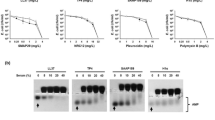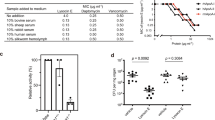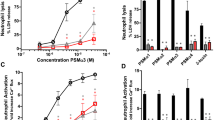Abstract
Human plasmain vitro inhibits the growth of coagulase negative staphylococci,S. epidermidis, which may be pathogenic in the immunocompromised host. To determine the antimicrobial components, serum was fractionated by column chromatography, which revealed that elution areas where lipoproteins can be yielded had high antimicrobial activity againstS. epidermidis. Therefore, lipoprotein fractions, including very low density lipoprotein (VLDL), low density lipoprotein (LDL) and high density lipoprotein (HDL), were separated by ultracentrifugation and incubated withS. epidermidis. All 3 lipoprotein fractions suppressed bacterial growth within the first 3 h but VLDL enhanced bacterial growth after 9 h of incubation compared with the control. HDL, however, inhibited bacterial growth throughout 21 h of incubation.
To confirm these results, serum from healthy volunteers was separated by ion exchange column chromatography and again by HPLC to purify the antimicrobial fraction. In the protein analysis with gradient polyacrylamide-SDS gel, apolipoprotein Al (apo Al), which is a major apolipoprotein of HDL, was detected in the antimicrobial fraction. Therefore, this fraction was loaded onto an immunoaffinity column coupled with the anti-apo Al monoclonal antibody (Mab). Unbound fraction had no antimicrobial activity, but anti-S. epidermidis activity was recovered from the bound fraction which consisted mainly of apo Al, All and apo C in protein composition.
These results indicated that the antimicrobial activity was associated with the apo Al-containing lipoprotein particles (HDL). This property of HDL may directly affect bacterial growth and promote the self-defense mechanisms of normal and immunocompromised individuals.
Similar content being viewed by others
References
Drutz DJ, Mills J: Immunity and infection. In: DP Sites et al. (eds) Basic and Clinical Immunology. 5th ed. Lange Med Publ, California, 1984, pp 197–222
Hirsch JG: Comparative bactericidal activities of blood serum and plasma serum. J Exp Med 112: 15–21, 1960
Gold MJ, Calmon J, Wendeler M, Levison ME, Johnson CC: Synergistic bactericidal activity of rat serum with vancomycin against Enterococci. J Infect Dis 163: 1358–1361, 1991
Hancock RE, Mutharia LM, Chan L, Darveau RP, Speert DP, Pier GB:Pseudomonas aeruginosa isolated from patients with cystic fibrosis: A class of serum-sensitive nontypable strains deficient in lipopolysaccharide O side chains. Infect Immun 42: 170–177, 1983
Sophianopoulos AJ, Rhodes CK, Holcomb DN, Van Holde KE: Physical studies of lysozyme. 1. Characterization. J Biol Chem 237: 1107–1112, 1962
Rogers HJ, Bullen JJ, Gushnie GH: Iron compounds and resistance to infection: Further experiments withClostridium welchii type Ain vivo andin vitro. Immunology 19: 521–538, 1970
Machida K, Moriwaki M, Hoshina S, Sakurai S, Kurosaka K, Ikawa S: Antimicrobial component in human sera againstStaphylococcus epidermidis. Jikeikai Med J 35: 343–349, 1988
Havel RJ, Eder HA, Bragdon JH: The distribution and chemical composition of ultracentrifugally separated lipoproteins in human serum. J Clin Invest 34: 1345–1353, 1955
Galfre G, Milstein C: Preparation of monoclonal antibodies: Strategies and procedures. Methods Enzymol 73: 3–46, 1981
Lowry OH, Rosebough NJ, Farr AL, Randall RJ: Protein measurement with the Folin phenol reagent. J Biol Chem 193: 265–275, 1951
Lewis B: The Hyperlipidemias: Clinical and Laboratory Practice. Blackwell, Oxford, 1976, pp 34–36
Miller GJ, Miller NE: Plasma high-density-lipoprotein concentration in the development of ischaemic heart disease. Lancet i: 16–19, 1975
Miller NE, Weinstein DB, Carew ET, Koschinsky T, Steinberg D: Interaction between high density and low density lipoproteins during uptake and degradation by cultured human fibroblast. J Clin Invest 60: 78–88, 1977
Steinberg D: Metabolism of lipoproteins and their role in the pathogenesis of atherosclerosis. Atherosclerosis Rev 18: 1–23, 1988
Gallin JI, Kaye D, O'Leary WM: Serum lipids and infection. New Engl J Med 281: 1081–1086, 1969
Alvarez C, Ramos A: Lipids, lipoproteins and apoproteins in serum during infection. Clin Chem 32: 142–145, 1986
Kerttula Y, Weber TH: Serum lipids in viral and bacterial meningitis. Scand J Infect Dis 18: 211–215, 1986
Sammalkorpi K, Valtonen V, Kerttula Y, Nikkilä E, Taskinen M-R: Changes in serum lipoprotein pattern induced by acute infections. Metabolism 37: 859–865, 1988
Lanza-Jacoby S, Lansey SC, Cleary MP, Rosato FE: Alterations in lipogenic enzymes and lipoprotein lipase activity during gramnegative sepsis in the rat. Arch Surg 117: 144–147, 1982
Beutler BA, Cerami A: Recombinant interleukin 1 suppresses lipoprotein lipase activity in 3T3-L1 cells. J Immunol 135: 3969–3971, 1985
Ehnholm C, Aho K, Huttunen JK, Kostiainen E, Mattila K, Pikkarainen J, Cantell K: Effect of interferon on plasma lipoproteins and on the activity of postheparin plasma lipases. Arteriosclerosis 2: 68–73, 1982
Rifkin MR: Identification of the trypanocidal factor in normal human serum: High density lipoprotein. Proc Natl Acad Sci USA 75: 3450–3454, 1978
Srinivas RV, Birkedal B, Owens BJ, Anantharamaiah GM, Segrest JP, Compans RW: Antiviral effects of apolipoprotein A-l and its synthetic amphipathic peptide analogs. Virology 176: 48–57, 1990
Owens BJ, Anantharamaiah GM, Kahlon JB, Srinivas RV, Compas RW, Segrest JP: Apolipoprotein A-l and its amphipathic helix peptide analogues inhibit human immunodeficiency virus-induced syncytium formation. J Clin Invest 86: 1142–1150, 1990
Kane JP, Hardman DA, Dimpfl JC, Levy JA: Apolipoprotein is responsible for neutralization of xenotropic tyce C virus by mouse serum. Proc Natl Acad Sci USA 76: 5957–5961, 1979
Rifkin MR: Role of phospholipids in the cytotoxic action of high density lipoprotein on trypanosomes. J Lipid Res 32: 639–647, 1991
Rifkin MR:Trypanosoma brucei: Cytotoxicity of host high density lipoprotein is not mediated by apolipoprotein A-l. Exp Parasitol 72: 216–218, 1991
Ulevitch RJ, Johnston AR, Weinstein DB: New function for high density lipoproteins: Their participation in intravascular reactions of bacterial lipopolysaccharides. J Clin Invest 64: 1516–1524, 1979
Schafer WM, Martin LE, Spitznagel JK: Cationic antimicrobial proteins isolated from human neutrophil granulocytes in the presence of diisopropyl fluorophosphate. Infect Immun 45: 29–35, 1984
Kagan BL, Selsted ME, Ganz T, Lehrer RI: Antimicrobial defensin peptides form voltage-dependent ion-permeable channels in planar bilayer membranes. Proc Natl Acad Sci USA 87: 210–214, 1990
Borenstein LA, Selested ME, Lehrer RI, Miller JN: Antimicrobial activity of rabbit leukocyte defensins againstTreponema pallidum subsp.pallidum. Infect Immun 59: 1359–1367, 1991
Hook WA, Tsuji S, Siraganian RP: Magainin-2 release histamine from rat mast cells. Proc Soc Exp Biol Med 193: 50–55, 1990
Darveau RP, Cunningham MD, Seachord CL, Cassiano-Clough L, Cosand WL, Blake J, Watkins CS: Beta-lactam antibiotics potentiate magainin 2 antimicrobial activityin vivo andin vitro. Antimicrob Agents Chemother 35: 1153–1159, 1991
Matsuzaki K, Fukui M, Fujii N, Miyajima K: Interaction of an antimicrobial peptide, tachyplesin I with lipid membranes. Biochim Biophys Acta 1070: 259–264, 1991
Lee S, Yoshida M, Mihara H, Aoyagi H, Kato T, Yamasaki N: The spectroscopic analysis for binding of amphipathic and antimicrobial model peptides containing pyrenylalanine and tryptophan to lipid bilayer. Biochim Biophys Acta 984: 174–182, 1989
Miller SJ, Aly R, Shinefield HR, Elias PM:In vitro andin vivo antistaphylococcal activity of humanstratum corneum lipids. Arch Dermatol 124: 209–215, 1988
Bibel DJ, Miller SJ, Brown BE, Pandey BB, Elias PM, Shinefield HR, Aly R: Antimicrobial activity ofstratum corneum lipids from normal and essential fatty acid-deficient mice. J Invest Dermatol 92: 632–638, 1989
Panyutich A, Ganz T: Activated alpha 2-macroglobulin is a principal defensin-binding protein. Am J Respir Cell Mol Biol 5: 101–106, 1991
Agawa Y, Lee S, Ono S, Aoyagi H, Ohno M, Taniguchi T, Anzai K, Kirino Y: Interaction with phospholipid bilayers, ion channel formation, and antimicrobial activity of basic amphipathic alpha-helical model peptides of various chain lengths. J Biol Chem 266: 20218–20222, 1991
Author information
Authors and Affiliations
Rights and permissions
About this article
Cite this article
Tada, N., Sakamoto, T., Kagami, A. et al. Antimicrobial activity of lipoprotein particles containing apolipoprotein Al. Mol Cell Biochem 119, 171–178 (1993). https://doi.org/10.1007/BF00926868
Issue Date:
DOI: https://doi.org/10.1007/BF00926868




